With the right tandem kayak, fishing is twice the fun. A tandem kayak allows two people to fish from one boat, expanding your angling circle to include friends and family. The best tandem kayaks for fishing feature stable hulls, comfortable seats and plenty of room for casting and landing fish. Rig a tandem for one angler and use the extra space for more fishing and camping gear. Or, choose a tandem kayak with a pedal system for a serious two-person fishing machine.
Top picks: Best 2-person fishing kayaks for 2025
The following tandem fishing kayaks have received the highest star ratings by reviewers in our Paddling Buyer’s Guide. See and review all 2-person fishing kayaks here.
Best Tandem Fishing Kayaks
-first_product_boats.jpg)
BKC TK122 Angler Tandem Coastal Cruiser Kayak
Shop for tandem fishing kayaks
Follow the links below to the Paddling Buyer’s Guide where you’ll find every tandem kayak for fishing along with specs, prices, reviews and places to buy.
Shop by type
Shop by propulsion
Shop by brand
Aquaglide tandem fishing kayaks
Brooklyn Kayak Company tandem fishing kayaks
Feelfree tandem fishing kayaks
Hobie tandem fishing kayaks
Intex 2-person fishing kayaks
Native Watercraft tandem fishing kayaks
NuCanoe tandem fishing kayaks
Sea Eagle tandem fishing kayaks
Sevylor tandem fishing kayaks
SKANU tandem fishing kayaks
Vibe tandem fishing kayaks
Wilderness Systems tandem fishing kayaks
Shopping for a used tandem fishing kayak?
Tandem fishing kayaks aren’t as popular as single-seat fishing sit-on-tops so used boats are more difficult to find. But, a two-person kayak usually isn’t used as often as a solo kayak, so a second-hand tandem should be in better condition than a used solo boat. Since two people paddle a tandem, there is usually someone to help carry the boat to the launch instead of one person dragging a solo boat across the ground. If you can find a tandem kayak on the used market, chances are it will be in pretty good condition.
First, check if both seats work properly and are undamaged. Install and remove the seats and take a test drive to make sure the seat’s position adjusts properly. Look for fading, sagging or ripped seat fabric. In most cases the seat is replaceable, but a low-profile seat costs over $100 and a frame seat could set you back many times that price. A bad seat isn’t a deal breaker, but take replacement cost into consideration when negotiating the price.
Tandems carry more weight so there is greater risk of damage to the plastic. Search for cracks around the seat bases, scupper holes and seams in the plastic. Minor plastic damage, like a small hole or crack above the waterline, is easy to fix with a plastic patch and a heat gun. Larger holes or damage to the plastic below the waterline require a more involved repair with a plastic welder and steel mesh.
For more tips on what to look for when selecting a used fishing kayak, read our article How To Buy A Used Fishing Kayak.
Tandem fishing kayak buying guide
Tandem fishing kayaks offer the opportunity to fish with friends and family in a small boat. In a tandem kayak, one person sits toward the bow and another person the stern. Most tandem kayaks are propelled by double-bladed kayak paddles, but some models use a pedal propulsion system and there are a few motorized two-person kayaks for fishing.
The most popular tandem kayaks for fishing are sit-on-top models made of rotomolded plastic with scuppers to drain water. The boats have space for two seats and room for fishing gear and accessories.
Consider the size
Remember, tandem kayaks for fishing are longer, wider and heavier than a tandem recreational kayak or a single seat boat. For example, an average rec tandem kayak is 12 feet long and 30 inches wide. For greater stability to cast and fight fish and more capacity for fishing gear, the best tandem for fishing is 40 inches wide and over 13 feet long.
A large fishing tandem is more difficult to transport and requires more space to store. With some effort, and help from a buddy, you can wrestle a fishing tandem onto a sturdy roof rack. We recommend carrying the two-seater in a pickup truck with a bed extender or a small trailer.
For folks with limited storage and transportation options, we recommend an inflatable tandem kayak or a recreational sit-inside tandem. These boats are lighter and easier to move, but they don’t have as much space as a full-size fishing tandem.
Consider how you will use it
Before searching for the best two-person kayak, consider how you will use the boat. If you plan to take another adult kayak fishing, look for a full-size tandem kayak with elevated frame seats and plenty of space to fish.
To accommodate a child or pet, check out a smaller, lighter tandem that is easier to paddle solo and still has plenty of space for smaller guests. A narrower and shorter tandem is lighter and easier for a single paddler to paddle.
The best two-person fishing kayak is a fully featured machine with plenty of space for casting and retrieving lures. At over 14-feet long, 40-inches wide with more than 400 pounds of capacity, a full-size tandem fishing kayak is a powerful platform for serious fishing.
This may seem like a lot of boat, but the extra space and capacity will be appreciated on the water. With two people paddling or pedaling, the effort is shared.
Look for a tandem kayak with elevated, adjustable frame seats. Frame seats resemble a folding lawn chair elevated off the kayak deck on four short legs. A higher seat makes it easier to cast a fishing rod and work a lure. These seats are also wider and more adjustable than a low-profile seat, so they are more comfortable for long days on the water.
A full-size, two-person kayak has plenty of space for fishing. Look for a large tankwell in the stern and a bow well or hatch in the front of the boat. The tankwell is a molded space behind the seat to hold a gear crate and vertical rod holders. A bow well is a molded space in the bow with room for a couple of tackle boxes and a dry bag, usually secured by a mesh cover or bungees.
A bow hatch, on the other hand, provides access to the inside of the hull to carry more gear or rig the boat with electronics and battery. It boils down to this: a bow well is great for quick access to gear you need most often while a bow hatch carries more stuff and protects it from the elements.
The seats should be spaced far enough apart to allow for casting, rigging, working a lure and fighting a fish. With two anglers swinging fishing rods and sharp hooks, space is at a premium to avoid tangles and injury. Each boat has different dimensions, so there’s no equation for seat spacing. The best bet is going with the longest, widest kayak for fishing.
Pedal or paddle?
Large kayaks are more difficult to paddle and maneuver than a solo kayak or smaller recreational tandem. Luckily, two paddlers are better than one. Working together, a pair of anglers can efficiently paddle a full-size fishing tandem. Another option is to choose a pedal or motor-powered tandem. These boats are more expensive and require some basic maintenance and care to own.
A pedal system or motor can add thousands to the cost of the kayak. Taking care of the pedal system requires regular washing and upkeep of prop pins, gears, pedals and the rudder. But the power of the pedal or motor to move a tandem kayak for fishing can make the complications worthwhile.
Sit-on-top or sit-inside?
Some anglers prefer a sit-inside tandem kayak. Unlike a sit-on-top kayak, sit-inside anglers sit inside the cockpit, just inches off the bottom of the boat. Sit-inside tandem kayaks are lighter than a similar-sized sit-on-top, so they are easier to carry and paddle. The lower seat places the paddler closer to the water.
This allows him to use a shorter paddle shaft, around 210 cm, which transfers more power with less energy to move the boat forward. On the other hand, the long paddle shaft, up to 255 cm, required for a sit-on-top with elevated seats is less efficient.
Inflatable or hard-shell?
Another option is an inflatable tandem kayak. Inflatables are lighter and more compact than a sit-on-top kayak. Uninflated, the boat fits into a suitcase. Inflated, the tandem kayak is a tough and versatile platform for fishing. Inflatable kayaks allow anglers with limited storage and transportation more options to get on the water. They are great for bouncing down a rocky river or traveling to distant fishing destinations.
The downside: inflatables do not perform as well as a traditional kayak. The shallow draft and large profile make the air-filled boats vulnerable to wind and current so they are more difficult to paddle straight or fast than a similar-sized rotomolded plastic kayak.
There are a lot of options for tandem fishing kayaks, and one is bound to meet your needs. Whether you go with a full-feature, full-size two-man fishing machine or a simple, streamlined grab and go recreational kayak, there’s a tandem fishing kayak for every angler, plus a friend.
-
Can you fish from a tandem kayak?
When you want to take a family member, friend or pet fishing, nothing beats the intimacy and excitement of a tandem fishing kayak. The best two-person fishing kayak has plenty of space for fishing and capacity to carry a lot of gear. Smaller, lighter and more maneuverable sit-on-top kayaks make paddling easier but offer less space for fishing. Inflatable and sit-inside tandems are too compact and unstable to make a serious fishing practical, but inflatables are great for grab and go trips with limited gear.
Best tandem fishing kayak reviews
There’s no better way to choose a tandem fishing kayak than kicking the tires and taking a test drive. The staff at Kayak Angler, our sister magazine, have run the best two-person fishing kayaks through the gauntlet. We’ve rigged the boats for fishing, loaded them with gear and hit the water.
Our testing includes miles of pedaling and hours of fishing in a variety of conditions and locations. This allows us to evaluate how the boat handles and how it performs for the intended angler and conditions. If you can’t make it to the paddle shop or a demo day, take a test drive with our review of the best tandem fishing kayaks.
- Inflatable Kayak Review: Sevylor Colorado
- Inflatable Recreational Kayak Review: Intex Challenger K2
- Inflatable Kayak Review: Advanced Elements AdvancedFrame Convertible Elite



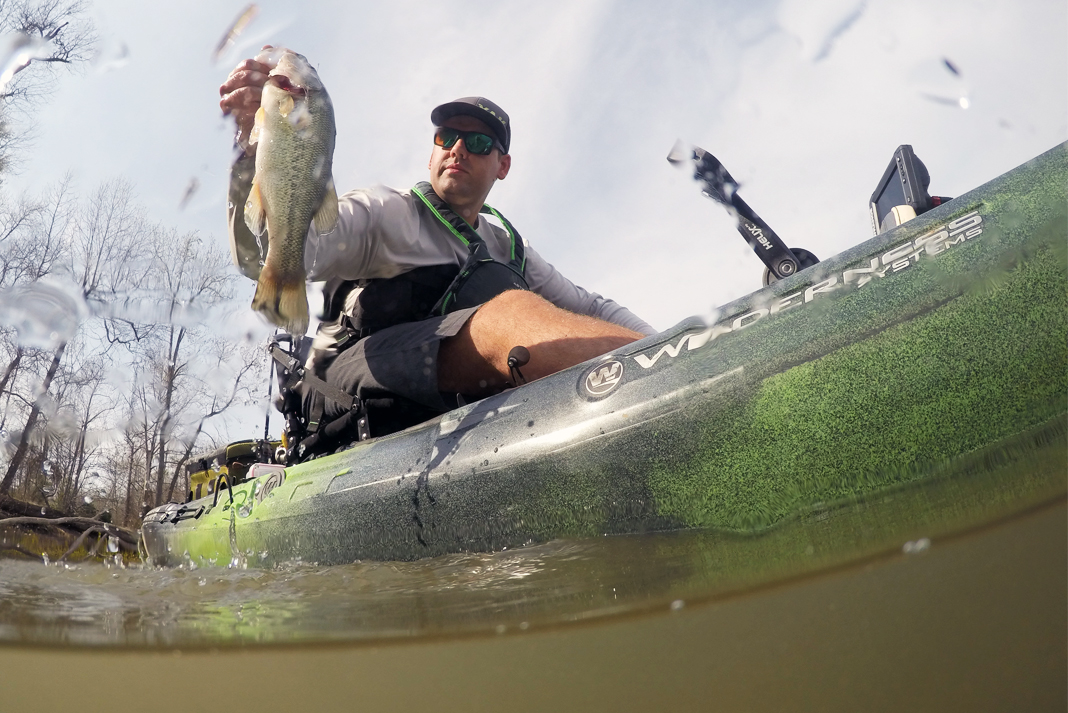
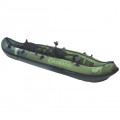
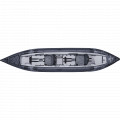
-first_product_boats.jpg)
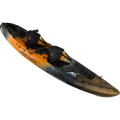
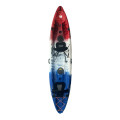
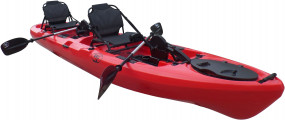

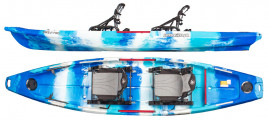
-first_product_boats.jpg)
